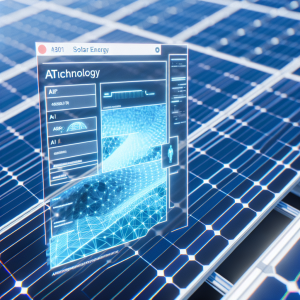-
- Unlocking AI Efficiency: Transforming Solar Energy Optimization for a Greener Future
- The Importance of AI in Solar Energy Optimization
- Configuration Steps for AI-Driven Solar Energy Optimization
- Step 1: Data Collection
- Step 2: Data Preprocessing
- Step 3: Model Selection
- Step 4: Training the Model
- Step 5: Implementation and Monitoring
- Best Practices for AI-Driven Solar Energy Optimization
- Case Studies and Statistics
- Conclusion
Unlocking AI Efficiency: Transforming Solar Energy Optimization for a Greener Future
As the world grapples with climate change and the urgent need for sustainable energy solutions, solar energy has emerged as a leading contender in the quest for a greener future. However, optimizing solar energy systems for maximum efficiency remains a challenge. The integration of Artificial Intelligence (AI) into solar energy management presents a transformative opportunity to enhance performance, reduce costs, and increase the adoption of renewable energy sources. This guide will explore actionable steps to unlock AI efficiency in solar energy optimization, supported by practical examples, best practices, and relevant statistics.
The Importance of AI in Solar Energy Optimization
AI technologies can analyze vast amounts of data, predict energy production, and optimize system performance in real-time. By leveraging machine learning algorithms and data analytics, solar energy systems can achieve:
- Improved energy yield
- Reduced operational costs
- Enhanced predictive maintenance
- Better integration with smart grids
These advancements not only contribute to a more sustainable energy landscape but also drive economic benefits for stakeholders in the solar industry.
Configuration Steps for AI-Driven Solar Energy Optimization
Step 1: Data Collection
The first step in optimizing solar energy systems with AI is to gather relevant data. This includes:
- Solar irradiance levels
- Temperature data
- Energy output from solar panels
- Weather forecasts
- Historical performance data
Utilize sensors and IoT devices to collect real-time data from solar installations.
Step 2: Data Preprocessing
Once data is collected, it must be cleaned and preprocessed to ensure accuracy. This involves:
- Removing outliers and erroneous data points
- Normalizing data for consistency
- Handling missing values through interpolation or imputation
Step 3: Model Selection
Select appropriate machine learning models for analysis. Common models include:
- Linear Regression for predicting energy output
- Random Forest for classification tasks
- Neural Networks for complex pattern recognition
Choose models based on the specific requirements of your solar energy system.
Step 4: Training the Model
Train the selected model using the preprocessed data. This involves:
- Splitting the dataset into training and testing sets
- Using libraries such as TensorFlow or Scikit-learn for implementation
- Evaluating model performance using metrics like Mean Absolute Error (MAE) or Root Mean Square Error (RMSE)
Example code snippet for training a linear regression model:
from sklearn.model_selection import train_test_split
from sklearn.linear_model import LinearRegression
from sklearn.metrics import mean_absolute_error
# Assuming 'data' is a DataFrame containing the solar data
X = data[['irradiance', 'temperature']]
y = data['energy_output']
X_train, X_test, y_train, y_test = train_test_split(X, y, test_size=0.2, random_state=42)
model = LinearRegression()
model.fit(X_train, y_train)
predictions = model.predict(X_test)
mae = mean_absolute_error(y_test, predictions)
print(f'Mean Absolute Error: {mae}')
Step 5: Implementation and Monitoring
Deploy the trained model into the solar energy system for real-time optimization. Continuous monitoring is essential to:
- Track performance metrics
- Adjust model parameters as needed
- Implement feedback loops for ongoing learning
Best Practices for AI-Driven Solar Energy Optimization
To maximize the effectiveness of AI in solar energy systems, consider the following best practices:
- Invest in high-quality sensors for accurate data collection.
- Regularly update models with new data to improve predictions.
- Collaborate with data scientists to refine algorithms.
- Utilize cloud computing for scalable data processing.
Case Studies and Statistics
Several organizations have successfully implemented AI in solar energy optimization:
- Google: Utilized AI to optimize energy usage in its data centers, achieving a 40% reduction in energy consumption.
- SolarCity: Employed machine learning algorithms to predict solar panel performance, resulting in a 20% increase in energy yield.
According to a report by the International Renewable Energy Agency (IRENA), AI can enhance solar energy efficiency by up to 30%, making it a critical component in the transition to renewable energy.
Conclusion
Integrating AI into solar energy optimization is not just a technological advancement; it is a necessary step towards a sustainable future. By following the outlined configuration steps, adopting best practices, and learning from successful case studies, stakeholders can significantly enhance the efficiency and effectiveness of solar energy systems. As we move forward, embracing AI will be crucial in unlocking the full potential of solar energy, paving the way for a greener and more sustainable world.
